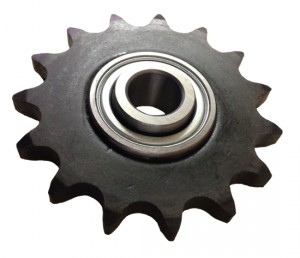Steel idler sprockets maintain proper chain tension, and guidebook the chain around obstacles and stop excessive chain wear and vibration. You don’t need any special tightener shafts for ball bearing idler sprockets. Composite sprocket idlers require no lubrication and are corrosion resistant and wear-resistant.
An idler sprocket is a gadget used to maintain the strain in a chain or chain drive program. Often consisting of only a sprocket installed on a springtime tensioned arm, the idler sprocket pulls 
When traveling a machine simply by chain, the strain of the chain must be kept at a constant to avoid the chain coming from the drive sprockets. By setting up an idler sprocket in the drive program, the chain is held taut while not being over-tightened. Operating a chain in an over-limited condition can lead to premature bearing and chain failing while an idler sprocket positioned in the program is often a way to greatly extend the life of the chain, sprockets and the bearings on the machine’s sprocket shafts.
The ideal installing the idler sprocket is on the opposite side of the chain between the drive sprocket and the driven sprocket. The application should place the idler sprocket ready which has the sprocket pushing or pulling the chain towards itself since it loops the two main sprockets in a shape like the letter B. This style will allow the pulleys to draw the chain hard without hindering the idler at all as the drive chain passes over the sprocket. If a condition presents itself which needs the drive to exert extra strain on the drive chain, the idler will flex against the chain, and can expand while leftover in contact with the drive sprockets.
While the the greater part of idler sprockets are manufactured of steel, many materials are used to produce an idler sprocket. Many poly or composite sprockets have been used in combination with great success and some wooden sprockets have also been applied to some machinery without concern. Many machines, so that they can reduce the put on on the drive chain, use an light weight aluminum, cast iron or metal sprocket coated in a nylon materials. The metallic hub allows the idler sprocket to remain very strong while the nylon covering is usually mild on the chain links.